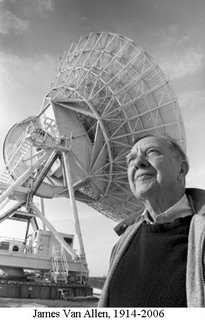
"The picture we carry of Jim Van Allen in our own mind is something quite different than that photo depicts."U.S. space pioneer and distinguished physicist James Van Allen died today at the age of 91. As described in an official release from the University of Iowa, where he worked for many decades:
The highlight of Van Allen's long and distinguished career was his use of UI-built instruments carried aboard the first successful U.S. satellite, Explorer 1, in 1958 to discover bands of intense radiation -- later known as the Van Allen radiation belts -- surrounding the Earth. It came at the height of the U.S.-Soviet space race and literally put the United States on the map in the field of space exploration.Colleagues, friends, and family will have a great many stories to tell of this wonderfully gentle, generous, and humorous man who lived among us. For ourselves, what we remember most was his abiding humility and his child-like wonder at the universe.
Among the other accomplishments of which he was most proud was his 1973 first-ever survey of the radiation belts of Jupiter using the Pioneer 10 spacecraft and his 1979 discovery and survey of Saturn's radiation belts using data from the Pioneer 11 spacecraft. Ever a critic of manned space flight, Van Allen the scientist described himself as "a member of the loyal opposition" when it came to discussions of big-budget space programs, declaring that space science could be done better and more cheaply when left to remote-controlled, unmanned spacecraft. NASA's move toward cheaper, more focused unmanned spacecraft during the 1990s was, at least in part, a result of Van Allen's advocacy.
You can see on this page, above, a dramatic photograph of James Van Allen standing strong and resolute in front of one of the 10 VLB radio telescope antennas which became operational a little more than a decade ago. Each huge radio telescope, we are assured by an official University obituary, provides "the sharpest vision of any telescope on Earth or in space" with "an ability to see fine detail equivalent to being able to stand in New York and read a newspaper in Los Angeles."
Developing and deploying the VBLA network of telescopes was only one of Van Allen's many notable achievements in the field of radio astronomy. But the picture we carry of Jim Van Allen in our own mind is something quite different than that photo depicts.
It was a cold and crisp Christmas evening in the early 1980's, shortly before he was to formally retire as chairman of the University of Iowa's physics department. That week, his wife, Abby, had given him an 8-inch Schmidt-Cassegrain telescope.
It was a short, stubby thing; a commercially-produced telescope of the kind amauteur astronomers long for, but hardly something we would have expected a professional astronomer to want. After all, hadn't it been his Explorer 1 satellite (with help from a young student assistant, Donald Gurnett, with whom Jim always insisted on sharing the credit) that first discovered radiation belts surrounding the Earth? Wasn't it James Van Allen whose instruments aboard Pioneer 10 discovered radiation belts around Jupiter just two years later, and that continued sending radio signals back to Earth even as it became the first man-made object ever to leave the Solar System?
Surely he had at his command any professional telescope he might want, from the Palomar Observatory to Kitts Peak -- not to mention the smaller telescope whose silver dome had topped MacLean Hall on the Iowa campus for decades. However much ordinary people might covet it, what did the famous astronomer James Van Allen need with a modest, off-the-shelf telescope like this?
Because the Van Allen household had been consumed with the last-minute preparations for the holiday party he and Abby always gave for friends and their children -- and had used what little free time they had left that day to rehearse their parts in the annual parody Christmas play always written by his good friend, Prof. John C. Gerber -- Van Allen confided that he hadn't had a chance to use the telescope yet.
The play was over. The joke-presents had been opened by all. While everyone else continued partying, would we like to sneak outside with him and take a look through his new telescope?
The air was cold enough to freeze the cheeks. The night was as dark as black velvet, studded with countless brilliant diamonds. Working together in gloves and heavy coats, we awkwardly hauled the telescope outside, down the steps of the deck, and set it on a tripod perched precariously on the frozen grass of his backyard.
"Have a look," Van Allen said.
"You first," we replied.
He leaned down to fit an eye to the 'scope, adjusted the short tube with a mittened hand, found his target, and uttered a single word.
"Wow."
We said something inane on the order of, "You must have seen the sky a million times."
"Not at all!" he exclaimed. "You know, mostly I just see printouts of radio signals while sitting at my desk. But this -- the sky -- the Universe -- It's all so very beautiful!"
The Iowa City Press-Citizen has a loving obituary, quoting many of James Van Allen's friends and relatives.
The student newspaper, Daily Iowan, has more.






No comments:
Post a Comment